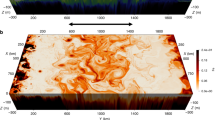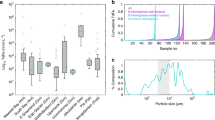Abstract
Low levels of iron limit primary productivity across much of the Southern Ocean. At the basin scale, most dissolved iron is supplied to surface waters from subsurface reservoirs, because land inputs are spatially limited. Deep mixing in winter together with year-round diffusion across density surfaces, known as diapycnal diffusion, are the main physical processes that carry iron-laden subsurface waters to the surface. Here, we analyse data on dissolved iron concentrations in the top 1,000 m of the Southern Ocean, taken from all known and available cruises to date, together with hydrographic data to determine the relative importance of deep winter mixing and diapycnal diffusion to dissolved iron fluxes at the basin scale. Using information on the vertical distribution of iron we show that deep winter mixing supplies ten times more iron to the surface ocean each year, on average, than diapycnal diffusion. Biological observations from the sub-Antarctic sector suggest that following the depletion of this wintertime iron pulse, intense iron recycling sustains productivity over the subsequent spring and summer. We conclude that winter mixing and surface-water iron recycling are important drivers of temporal variations in Southern Ocean primary production.
This is a preview of subscription content, access via your institution
Access options
Subscribe to this journal
Receive 12 print issues and online access
$259.00 per year
only $21.58 per issue
Buy this article
- Purchase on Springer Link
- Instant access to full article PDF
Prices may be subject to local taxes which are calculated during checkout




Similar content being viewed by others
References
Boyd, P. W. & Ellwood, M. J. The biogeochemical cycle of iron in the ocean. Nature Geosci. 3, 675–682 (2010).
Moore, C. M. et al. Processes and patterns of oceanic nutrient limitation. Nature Geosci. 6, 701–710 (2013).
Sarmiento, J. L., Hughes, T. M. C., Stouffer, R. J. & Manabe, S. Simulated response of the ocean carbon cycle to anthropogenic climate warming. Nature 393, 245–249 (1998).
Takahashi, T. et al. Climatological mean and decadal change in surface ocean pCO2, and net sea–air CO2 flux over the global oceans. Deep-Sea Res. II 56, 554–577 (2009).
Boyd, P. W. et al. Climate-mediated changes to mixed-layer properties in the Southern Ocean: Assessing the phytoplankton response. Biogeosciences 5, 847–864 (2008).
Tagliabue, A. et al. A global compilation of dissolved iron measurements: Focus on distributions and processes in the Southern Ocean. Biogeosciences 9, 2333–2349 (2012).
Boyd, P. W., Arrigo, K. R., Strzepek, R. & van Dijken, G. L. Mapping phytoplankton iron utilization: Insights into Southern Ocean supply mechanisms. J. Geophys. Res. 117, C06009 (2012).
Tagliabue, A. et al. Hydrothermal contribution to the oceanic dissolved iron inventory. Nature Geosci. 3, 252–256 (2010).
Boyd, P. W., Ibisanmi, E., Sander, S. G., Hunter, K. A. & Jackson, G. A. Remineralization of upper ocean particles: Implications for iron biogeochemistry. Limnol. Oceanogr. 55, 1271–1288 (2010).
Moore, J. K., Doney, S. C., Glover, D. M. & Fung, I. Y. Iron cycling and nutrient-limitation patterns in surface waters of the World Ocean. Deep-Sea Res. 49, 463–507 (2002).
Watson, A. J. in The Biogeochemical Cycle of Iron in Seawater (eds Turner, Keith David R. & Hunter, A.) (John Wiley, (2001) Ch. 2
De Baar, H. J. W. et al. Importance of iron for plankton blooms and carbon-dioxide drawdown in the Southern-Ocean. Nature 373, 412–415 (1995).
Toggweiler, J. R. & Russell, J. Ocean circulation in a warming climate. Nature 451, 286–288 (2008).
Boyd, P. W. et al. Microbial control of diatom bloom dynamics in the open ocean. Geophys. Res. Lett. 39, L18601 (2012).
Frew, R. D. et al. Particulate iron dynamics during FeCycle in subantarctic waters southeast of New Zealand. Glob. Biogeochem. Cycles 20, GB1S93 (2006).
Bowie, A. R. et al. Biogeochemical iron budgets of the Southern Ocean south of Australia: Decoupling of iron and nutrient cycles in the subantarctic zone by the summertime supply. Glob. Biogeochem. Cycles 23, GB4034 (2009).
Boyd, P. W. et al. FeCycle: Attempting an iron biogeochemical budget from a mesoscale SF6 tracer experiment in unperturbed low iron waters. Glob. Biogeochem. Cycles 19, GB4S20 (2005).
Croot, P. L. et al. Physical mixing effects on iron biogeochemical cycling: FeCycle experiment. J. Geophys. Res. 112, C06015 (2007).
Johnson, K. S., Gordon, R. M. & Coale, K. H. What controls dissolved iron concentrations in the world ocean?. Mar. Chem. 57, 137–161 (1997).
Sallée, J-B., Speer, K., Rintoul, S. & Wijffels, S. Southern Ocean thermocline ventilation. J. Phys. Oceanogr. 40, 509–529 (2010).
Law, C. S. Vertical eddy diffusion and nutrient supply to the surface mixed layer of the Antarctic Circumpolar Current. J. Geophys. Res. 108, 3272 (2003).
Cisewski, B., Strass, V. H. & Prandke, H. Upper-ocean vertical mixing in the Antarctic Polar Front Zone. Deep-Sea Res. 52, 1087–1108 (2005).
Wu, L., Jing, Z., Riser, S. & Visbeck, M. Seasonal and spatial variations of Southern Ocean diapycnal mixing from Argo profiling floats. Nature Geosci. 4, 363–366 (2011).
Frants, M. et al. Analysis of horizontal and vertical processes contributing to natural iron supply in the mixed layer in southern Drake Passage. Deep-Sea Res. II 90, 68–76 (2013).
Ellwood, M. J., Boyd, P. W. & Sutton, P. Winter-time dissolved iron and nutrient distributions in the Subantarctic Zone from 40–52S; 155–160E. Geophys. Res. Lett. 35, L11604 (2008).
Wagener, T., Guieu, C., Losno, R., Bonnet, S. & Mahowald, N. Revisiting atmospheric dust export to the Southern Hemisphere ocean: Biogeochemical implications. Glob. Biogeochem. Cycles 22, GB2006 (2008).
Lannuzel, D. et al. Distribution of dissolved iron in Antarctic sea ice: Spatial, seasonal, and inter-annual variability. J. Geophys. Res. 115, G03022 (2010).
Lin, H., Rauschenberg, S., Hexel, C. R., Shaw, T. J. & Twining, B. S. Free-drifting icebergs as sources of iron to the Weddell Sea. Deep-Sea Res. II 58, 1392–1406 (2011).
Raiswell, R., Benning, L. G., Tranter, M. & Tulaczyk, S. Bioavailable iron in the Southern Ocean: the significance of the iceberg conveyor belt. Geochem. Trans. 9, 7 (2008).
Gerringa, L. J. A. et al. Iron from melting glaciers fuels the phytoplankton blooms in Amundsen Sea (Southern Ocean): Iron biogeochemistry. Deep-Sea Res. II 71–76, 16–31 (2012).
Nishioka, J., Ono, T., Saito, H., Sakaoka, K. & Yoshimura, T. Oceanic iron supply mechanisms which support the spring diatom bloom in the Oyashio region, western subarctic Pacific. J. Geophys. Res. 116, C02021 (2011).
Sarthou, G. et al. The fate of biogenic iron during a phytoplankton bloom induced by natural fertilisation: Impact of copepod grazing. Deep-Sea Res. II 55, 734–751 (2008).
Strzepek, R. F. et al. Spinning the ‘Ferrous Wheel’: The importance of the microbial community in an iron budget during the FeCycle experiment. Glob. Biogeochem. Cycles 19, GB4S26 (2005).
Sunda, W. G. & Huntsman, S. A. Iron uptake and growth limitation in oceanic and coastal phytoplankton. Mar. Chem. 50, 189–206 (1995).
Marchetti, A. et al. Ferritin is used for iron storage in bloom-forming marine pennate diatoms. Nature 457, 467–470 (2009).
Arrigo, K. R., van Dijken, G. L. & Bushinsky, S. Primary production in the Southern Ocean, 1997–2006. J. Geophys. Res. 113, C08004 (2008).
Mackie, D. S. et al. Biogeochemistry of iron in Australian dust: From eolian uplift to marine uptake. Geochem. Geophys. Geosys. 9, Q03Q08 (2008).
Gaiero, D. M., Probst, J. L., Depetris, P. J., Bidart, S. M. & Leleyter, L. Iron and other transition metals in Patagonian riverborne and windborne materials: Geochemical control and transport to the southern South Atlantic Ocean. Geochim. Cosmochim. Acta 67, 3603–3623 (2003).
Stammerjohn, S., Massom, R., Rind, D. & Martinson, D. Regions of rapid sea ice change: An inter-hemispheric seasonal comparison. Geophys. Res. Lett. 39, L06501 (2012).
Dierssen, H. M. Perspectives on empirical approaches for ocean color remote sensing of chlorophyll in a changing climate. Proc. Natl Acad. Sci. USA 107, 17073–17078 (2010).
Lovenduski, N. S. & Gruber, N. Impact of the Southern Annular Mode on Southern Ocean circulation and biology. Geophys. Res. Lett. 32, L11603 (2005).
Séférian, R. et al. Skill assessment of three earth system models with common marine biogeochemistry. Clim. Dynam. 40, 2549–2573 (2012).
Steinacher, M. et al. Projected 21st century decrease in marine productivity: a multi-model analysis. Biogeosciences 7, 979–1005 (2010).
Misumi, K. et al. The iron budget in ocean surface waters in the 20th and 21st centuries: projections by the Community Earth System Model version 1. Biogeosci. Discuss. 10, 8505–8559 (2013).
Marinov, I., Doney, S. C. & Lima, I. D. Response of ocean phytoplankton community structure to climate change over the 21st century: Partitioning the effects of nutrients, temperature and light. Biogeosciences 7, 3941–3959 (2010).
Henson, S., Cole, H., Beaulieu, C. & Yool, A. The impact of global warming on seasonality of ocean primary production. Biogeosciences 10, 4357–4369 (2013).
Sallee, J. B., Wienders, N., Speer, K. & Morrow, R. Formation of subantarctic mode water in the southeastern Indian Ocean. Ocean Dynam. 56, 525–542 (2006).
De Boyer Montegut, C., Madec, G., Fischer, A. S., Lazar, A. & Iudicone, D. Mixed layer depth over the global ocean: An examination of profile data and a profile-based climatology. J. Geophys. Res. 109, C12003 (2004).
Strzepek, R. F., Maldonado, M. T., Hunter, K. A., Frew, R. D. & Boyd, P. W. Adaptive strategies by Southern Ocean phytoplankton to lessen iron limitation: Uptake of organically complexed iron and reduced cellular iron requirements. Limnol. Oceanogr. 56, 1983–2002 (2011).
Acknowledgements
We thank all observational scientists that generously shared iron data (especially M. Klunder and P. Sedwick, who did so before publication), the GEOTRACES programme (www.geotraces.org), K. Arrigo and G. van Dijken for providing iron utilization data files and A. Barton for comments on the manuscript. The Argo float data were collected and made freely available by the International Argo Program (http://www.argo.ucsd.edu). This work benefitted from the support of the French Agence Nationale de la Recherche (ANR) grant ANR-10-LABX-18-01 of the national Programme Investissements d’Avenir, the CSIR Parliamentary Grant, NRF-SANAP and the EU FP7 Marie Curie International Research Staff Exchange Scheme (IRSES) Fellowship SOCCLI (The role of Southern Ocean Carbon cycle under CLImate change), which received funding from the European Commission’s Seventh Framework Programme under grant agreement 317699. J.B.S. received support from Agence Nationale de la Recherche (ANR), ANR-12-PDOC-0001, as well as from the British Antarctic Survey as a BAS Fellow. This research was partly supported by the Australian Government Cooperative Research Centres Programme through the Antarctic Climate and Ecosystems CRC (ACE CRC), University of Tasmania Rising Stars grant no B0019024 and Australian Antarctic Science project no 2900, the New Zealand Ministry for Science and Innovation and the Institute of Marine and Antarctic Studies, University of Tasmania.
Author information
Authors and Affiliations
Contributions
Led design of the study and writing of the manuscript (A.T.), assembly of the iron and Argo datasets and data analysis (A.T. and J-B.S.), additional physical flux analyses (A.T., J-B.S., M.L. and S.S.), biological rate measurements (P.W.B.) and additional iron observations (A.R.B.). All authors contributed to the overall experimental work, discussion of the results and their implications, as well as commenting on the manuscript.
Corresponding author
Ethics declarations
Competing interests
The authors declare no competing financial interests.
Supplementary information
Supplementary Information
Supplementary Information (PDF 7286 kb)
Rights and permissions
About this article
Cite this article
Tagliabue, A., Sallée, JB., Bowie, A. et al. Surface-water iron supplies in the Southern Ocean sustained by deep winter mixing. Nature Geosci 7, 314–320 (2014). https://doi.org/10.1038/ngeo2101
Received:
Accepted:
Published:
Issue Date:
DOI: https://doi.org/10.1038/ngeo2101
This article is cited by
-
Seasonal patterns in microbial carbon and iron transporter expression in the Southern Ocean
Microbiome (2023)
-
Persistent equatorial Pacific iron limitation under ENSO forcing
Nature (2023)
-
Wind-driven upwelling of iron sustains dense blooms and food webs in the eastern Weddell Gyre
Nature Communications (2023)
-
Cetacean distribution in relation to oceanographic features at the Kerguelen Plateau
Polar Biology (2022)
-
A review of the scientific knowledge of the seascape off Dronning Maud Land, Antarctica
Polar Biology (2022)



